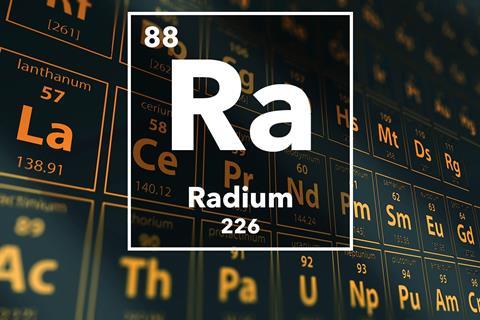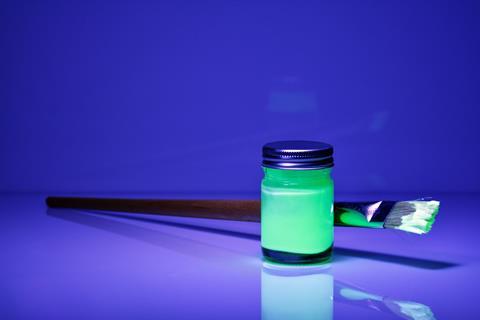Chris Smith
Hello, this week the self illuminating story of element number 88. Here's Brian Clegg.
Brian Clegg
There's something about radium that is deliciously Victorian. It's not just that this radioactive element was discovered at the end of the Victorian era in 1898. There's also something about its early use as a universal restorative that has a peculiarly period feel. It was seen as a source of energy and brightness, it was included in toothpastes and quack potions – it was even rubbed into the scalp as a hair restorer.

But the application of radium that would bring it notoriety was its use in glow-in-the-dark paint. Frequently used to provide luminous readouts on clocks and watches, aircraft switches and instrument dials, the eerie blue glow of radium was seen as a harmless, practical source of night time illumination. It was only when a number of the workers who painted the luminous dials began to suffer from sores, anaemia and cancers around the mouth that it was realized that something was horribly wrong. The women workers would regularly bring their paintbrushes to a point by licking them. This left enough radioactive residue in their mouths to cause cell damage. Eventually over 100 of the workers would die from the effects.

A more famous victim of radium was its discoverer, the double Nobel prize winner Marie Curie, born Maria Sklodowska. Working with her husband Pierre, Marie Curie was studying pitchblende, a mineral from North Bohemia that contained uranium. Pitchblende was mined near what's now Jachymov in the Czech Republic, and after the uranium had been extracted to be used to colour pottery glazes and tint photographs, the residual slag was dumped in a nearby forest. Without the uranium, the pitchblende proved still to be radioactive – in fact whatever the other radioactive material was, it was much more radioactive than the uranium itself.
Marie Curie wrote to sister Bronia that 'the radiation that I couldn't explain comes from a new chemical element. The element is there and I've got to find it! We are sure!' After working through tonnes of the pitchblende slag, the Curies identified two new elements in the remaining material – polonium and radium. They finally isolated radium in 1902 in its pure metal form. Radium was named for the Latin for a ray and proved to be the most radioactive natural substance ever discovered.

Although Marie Curie lived until 1934, her death from aplastic anaemia is almost certainly due to her exposure to radioactive materials, particularly radium. To this day her notebooks and papers have to be kept in lead lined boxes and handled with protective clothing, as they remain radioactive.
Radium occurs naturally as uranium decays – though only in very small quantities. It took many tonnes of pitchblende to produce the tenth of a gramme of radium that the Curies eventually extracted. It's classified in the periodic table as an alkaline earth metal – the heaviest of the series – putting it alongside more familiar metals like magnesium and calcium. With atomic number 88, it has four natural isotopes of atomic weight 228, 226, 224 and 223 - though there are a remarkable 21 more artificial isotopes.
A later starring role for radium would be as the source of alpha particles - helium nuclei - used by Rutherford in 1909 at the Cavendish laboratory in Cambridge to fire at a thin gold foil. Radium decays to radon, throwing out an alpha particle from its nucleus. Unexpectedly, Rutherford's assistants Hans Geiger and Ernest Marsden found that a very few of the alpha particles bounced back – Rutherford likened it to 'firing a 15 inch shell at a piece of tissue paper and having it come back and hit you.' This behaviour was used to deduce the existence of a compact, dense nucleus in the atom – radium proved the key to unlocking the atom's structure.
Radium's main practical use has been in medicine, producing radon gas from radium chloride to be used in radiotherapy for cancer. This was a process started in Marie Curie's time. The early researchers found they received skin burns from handling the radioactive materials, and when the Curies worked with doctors, they discovered that radiation could be used to reduce or even cure tumours. This became known as Curie therapy, and the Sorbonne in Paris set up a laboratory partly for Curie to continue her research, and partly to study the medical applications of radiation, which would become known as the Radium Institute.

If you were to hold a piece of radium in your hand, it would feel warm. Initially a bright white, it would blacken as it reacted with the air to form radium nitride. It would stay solid – radium doesn't melt until around 700 degrees Celsius. It would also crackle and spit on the surface of your palm as it reacted with the water on your skin to produce radium hydroxide. Holding radium not something I'd recommend, though. Radium is constantly decaying, producing the alpha particles Rutherford used, beta particles, which are fast electrons, and gamma rays, like high energy X-rays, which would be slamming through your flesh, disrupting the DNA and causing cellular damage. The isotopes of radium vary in half life – the time it takes for half the molecules in a sample to delay – from 1,602 years for the most stable isotope, radium 226, to 11.4 days for radium 223.
This is an element to be handled with care. Yet for anyone brought up on children's fiction full of ray guns and in a world were there were still X-ray machines to check your shoe size, it has a nostalgic feel that will ever make it fascinating.
Chris Smith
One wonders whether the podcasters of next century will be talking the same way about mobile phones, microwave ovens and MRI scanners. That was Bristol based science writer Brian Clegg with the story of Radium. Next week to a metal capable of terrible cruelty to cancer.
Katherine Haxton
In the early 1960s, Barnett Rosenberg was conducting experiments on bacteria, measuring the effects of electrical currents on cell growth. The E.coli bacteria were abnormally long during the experiment, something that could not be attributed to the electric current. A number of platinum compounds were being formed due to reaction of the buffer and the platinum electrode. Cisplatin was found to inhibit cell division thus causing the elongation of the bacteria and was tested in was tested in mice for anticancer properties. Cisplatin today is widely used to treat epithelial malignancies with outstanding results in the treatment of testicular cancers.
Chris Smith
So we've got overgrown E.coli to blame for the discovery of platinum based anti cancer compounds. And you can find out how all of that came about with Keele University's Katherine Haxton on next week's Chemistry in its element. I'm Chris Smith, thank you for listening and for this week goodbye.













No comments yet